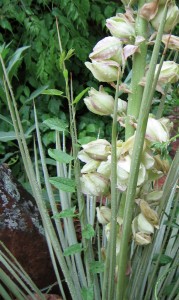Bindweed is thick and happy right now—at its seasonal height—and gardeners are scrambling to keep it under control. A year ago at this time I wondered: If every being serves some positive purpose, what might bindweed be contributing? The post sparked a lively conversation in the comments, and one astute reader corrected my starting point: the bindweed we dig out of our gardens is NOT native to this area. But even so, it has been used by native people for many medicinal purposes, which you can find at the end of the post.
It’s the bane of gardeners throughout the arid West— the boa constrictor of the weed world, twirling nasty vines around other plants, stretching its stringy rhizomes underground for what appear to be miles. Gardeners in Boulder joke that “it’s all just one bindweed,” impossible to get rid of. Here it is ascending a blooming yucca near my house, circling counterclockwise as it always does up a stem. It is said that bindweed can complete one circle in two hours. Talk about a blight!
the boa constrictor of the weed world, twirling nasty vines around other plants, stretching its stringy rhizomes underground for what appear to be miles. Gardeners in Boulder joke that “it’s all just one bindweed,” impossible to get rid of. Here it is ascending a blooming yucca near my house, circling counterclockwise as it always does up a stem. It is said that bindweed can complete one circle in two hours. Talk about a blight!
In the native plant garden at Chautauqua, the other volunteers and I spend hours digging it out, trying to prevent it from choking out the precious native wildflowers. All, it seems, to no avail. Bindweed is a public enemy—out to take over the world.
Or is it?